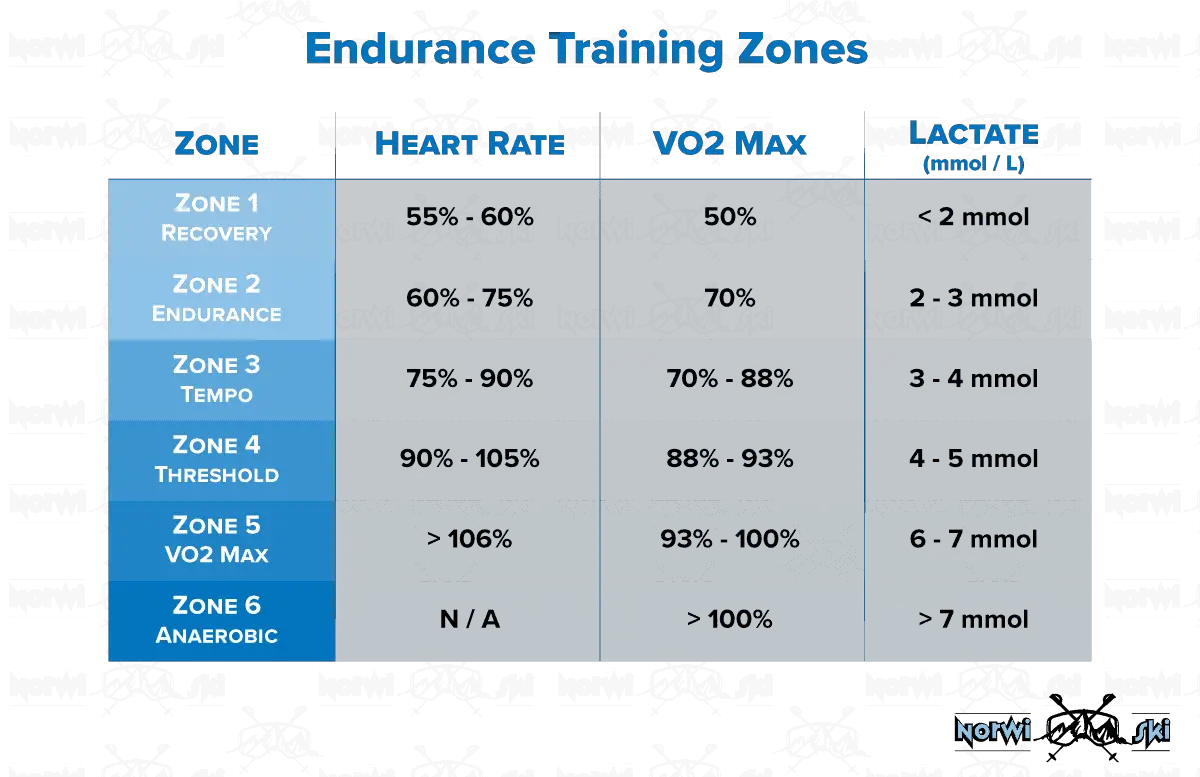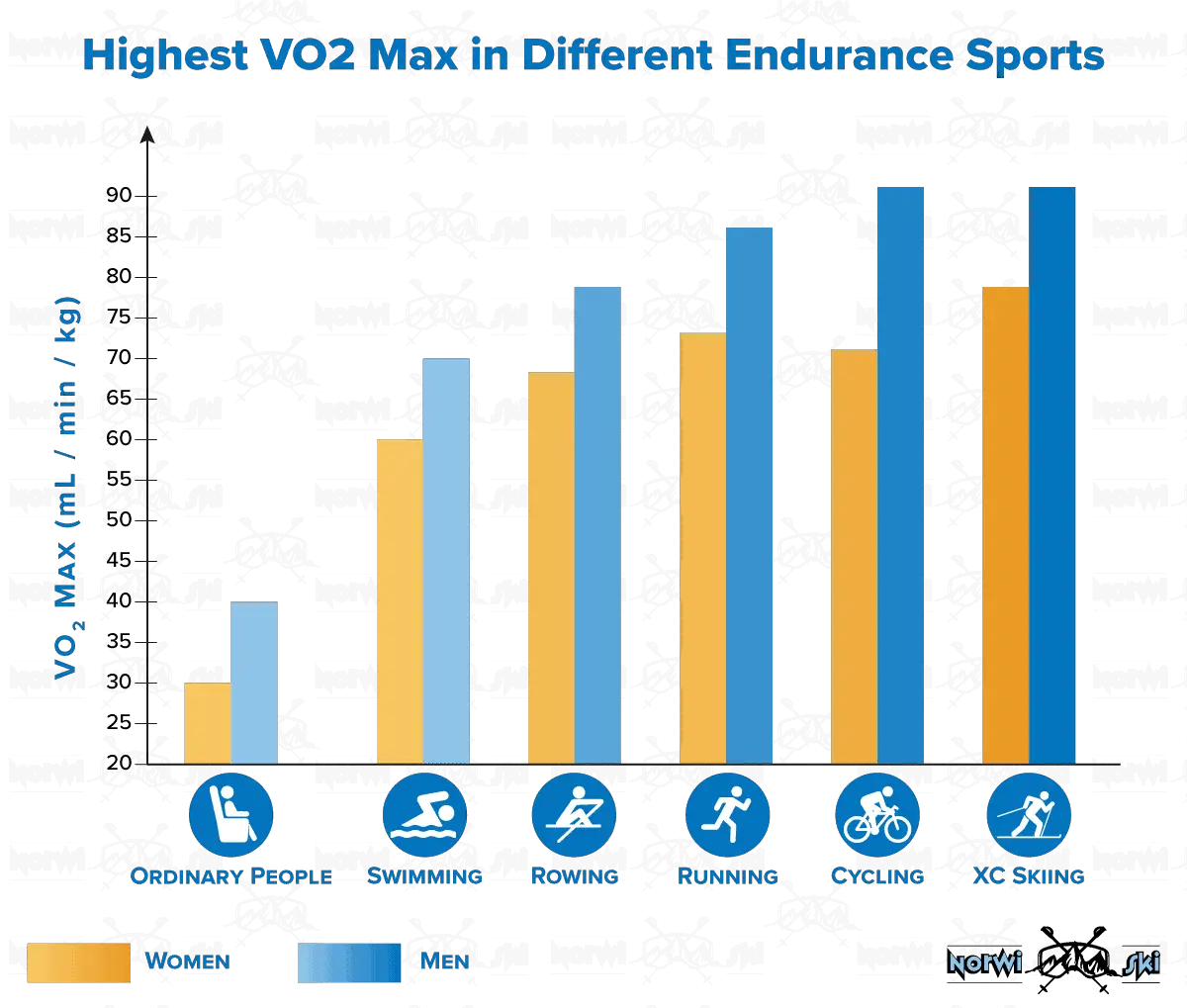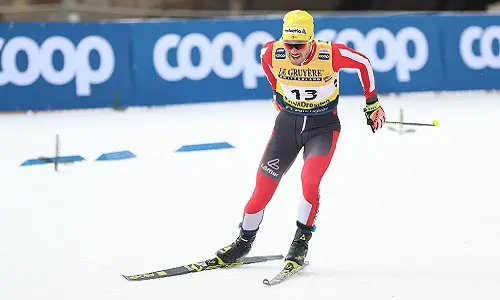Table of Contents
Cross-country skiing is seen as one of the most physically demanding, high endurance sports. While Nordic skiing, the faster you ski the harder it gets on your muscles as they require more oxygen to keep up with the pace. This is when the continuous balance act of aerobic and anaerobic metabolisms come into play.
Aerobic and Anaerobic Mechanisms during Endurance Training
During cross-country skiing, just as during any endurance exercise, the body uses both aerobic and anaerobic mechanisms to extract energy at low and high intensities, respectively. During cross-country skiing the adequately trained body tries to keep the anaerobic metabolism at bay as long as it can.
But let’s discuss what these two mechanisms actually mean:
Aerobic metabolism is dependent on oxygen and utilized during distance trainings, taking up a lot more energy from the skier, as compared to anaerobic metabolism, by breaking down body fats instead of glucose.
Anaerobic metabolism is triggered when the pace or intensity of the activity increases, and essentially means that the body’s oxygen demand is greater than its supply, as the body finds it hard to cope with such demand.
Aerobic metabolism is relatively slow and activated due to the amount of time available to the body to break down and utilize fats, while in the case of anaerobic metabolism, it only kicks in along with the production of lactic acid, when the body is put under stress for optimum performance; this can be taxing on the body, and needs to be utilized in smaller stints.
The purpose of endurance (or distance) training is to enhance the efficiency and time frame within which the aerobic metabolism stays dominant; otherwise, the body is bound to be fatigued quickly with long term side effects. There is a long list of benefits associated with appropriate endurance training. These include increased blood, stroke and heart volume, oxygen uptake, enhanced optimum cardiac output, increased capillary density, increased mitochondria density, increased activity of citric acid cycle enzymes, and a lowered resting heart rate.
Scientists have come up with identified ‘training zones’ to optimize the above mentioned benefits of endurance training and minimize the fatigue that can be a natural by-product of incorrectly executed distance training. They have identified five physiological training zones, and it is important to note that all endurance training ought to be kept within zones one and two only.

Endurance Training Zones and VO2 Max
Cross-country skiing being one of the most physically challenging and exhausting endurance sports is known to produce incredible performance levels when it comes to the aforementioned balancing act between aerobic and anaerobic mechanisms.
But the question is how can you measure your endurance level? This is when the often heard VO2 max comes into action. What does VO2 max actually mean?
VO2 Max is the maximum volume (V) of Oxygen (O2) consumption which is measured during exercises that have an incremental increase in intensity. It is also known as maximal oxygen consumption, peak oxygen uptake, maximal aerobic capacity, or maximal oxygen uptake. In simple terms, VO2 Max is the measurement of an athlete’s physical shape.

Now let’s take a look at these five training zones:
- Zone one (or level one) is the easiest for aerobic endurance purposes and requires 60 percent of a person’s maximum heart rate, 50 percent of his maximum oxygen uptake (VO2 max), or a blood lactate level at 2.0 mmol or lower. This zone signifies that the body is on aerobic energy mode almost fully, with oxygen being readily available. As you will appreciate, this zone is generally used for low-intensity training, recovery periods and over-distance training. This can be a difficult zone to maintain for skiers who are used to the fast paced skiing, however, this is meant to be the most productive zone if you are looking for longer duration workouts.
- Zone two (or level two) is defined as the general endurance zone as the anaerobic energy consumption is increased gradually. Having said that, the aerobic energy mode is still dominant and this should also feel fairly easy on the body. Zone two can be seen as athlete’s 75 percent of maximum heart rate, 70 percent maximum VO2, or a blood lactate level between 2 and 3 mmol. Level 2 can be maintained for longer durations before fatigue kicks in. A good example is when a person cannot easily converse during the workout, then he is most likely going over the speed for his body’s energy requirements.
There is fine balance between the zones and what your body needs to do in order to train safely and longer within these zones. Recreational or professional athletes require proper coaching and guidance on the science behind these zones to avoid a performance slump due to over training and eventually becoming fatigued even during low intensity workouts.
- Zones three, four and five are meant to cater to the anaerobic metabolism and are utilized specifically for interval training. 80% of the total yearly volume focuses on endurance training, whereas the remaining 20% is attributable to intervals and strength training. It is important to understand that if you do not execute the endurance training aspect correctly, then the 80 percent of the total yearly training goes wrong too! Training excessively or hardly during distance workouts can be counterproductive in a more profound manner than training very slowly during interval sessions. The athletes and professionals need to comprehend the heart rate values in relation to their personal physiological training zones to avoid this pitfall.
Kings and Queens of VO2 max: The Cross-Country Skier Athletes
It is unfortunate how often people ignore the high endurance levels and VO2 max factors of cross country skiers and give more credit to marathon runners, swimmers, and even cyclists. In fact, cross-country skiing is one of the physically most demanding sport, but why?
Cross country skiers do not get much benefit from the gravitational force, unlike the downhill skiers. Nordic skiing also does not involve any kind of vehicle like cycling does. And if that is not enough, the cross country skiers use all their major body muscle groups to pass through both inclined and flat surfaces, unlike the runners where primarily only the lower body muscles are used.

Since professional cross-country have a super high score of VO2 max, that means that their bodies perform efficiently at transporting oxygen from the lungs to different muscle groups through the bloodstream. This extraordinarily high aerobic capacity provides the XC skiers with a high endurance level that is necessary to complete a race.
The fact remains the same, that is, a professional cross country skier outmatches the VO2 max level of all these stated sports. Let us dig more into numbers.
On average, a healthy male who does not train for any sport has a VO2 max level of 35 to 40 mL/ (kg . min) on average. For females who are healthy but do not indulge in any sort of endurance training, the VO2 max level is around 27 to 31 mL/ (kg . min). As you increase your training exercises, this VO2 max score increases, however, with your aging process, this score keeps on decreasing. For many people, VO2 max levels can increase by increasing their training, however, there could be some exceptional cases. Although oxygen uptake is more like an inherited ability, yet you can improve it by working out – no matter which gender you belong to.
Cross-Country Skiing and Other Endurance Sports
Let us compare cross-country skiing with other similar sports: As compared to high VO2 max sports that mostly use a certain region of muscles like swimming that uses primarily the upper body muscles and marathon running that mainly uses the lower body muscles where arms generally swing by freely, Nordic skiers use a combination of all the muscles. While their upper body muscles perform with poles on the flat as well as hilly surfaces, the super strong leg and hip muscles navigate the XC skiers. And since a cross country skier uses both upper as well as lower body muscles, this means that the core muscles are also engaged that indulge the abdomen and lower back muscles into some serious work.
For male Olympic swimmers, the VO2 max score is usually recorded around 70 mL/ kg/ min. For professional marathon runners that land at the top, this score is somewhere around 75 mL/ kg/ min. If you talk about professional cyclists, the VO2 max score can surpass the swimmers and runners and reach to an impressive high of 88 mL/ kg/ min.
In all these sports, women athletes are recorded to have a VO2 max around 10 points lower than their male counterparts. Though women have a smaller body structure and weigh less than the male athletes, male athletes have a higher percentage level of muscles and their testosterone helps them burn oxygen quickly.
But wait until you read about the whooping VO2 max numbers of cross country skiers. The highest VO2 max score comes from the cross country skiers where some have been tested to get as high as 96 ml/ kg/ min. Norwegian skier Bjorn Daehlie reached one of the highest scores of 96 VO2 max and amazed the world. What makes the XC skiers so fit? The fact is, cross country tournaments are one of the longest and toughest ones in Olympic where the terrain can be up to 31 miles (50 km) long, and not only that, this terrain is very steep and uneven.
We have already established the fact that cross country skiers, like a majority of endurance athletes, have a very high VO2 max score or in other words, they possess the maximal oxygen uptake level. This makes their bodies extra efficient and the process of oxygen being taken from the lungs and provided through the bloodstream to the upper and lower body muscles as well as the core is ultra efficient as well. The VO2 max may be an important factor in high level skiers, such as Marit Bjorgen, winning so many races.
Having said that, a high VO2 max score cannot win you a race on its own. Cross-country skiers need to be able to sprint which is an anaerobic capacity where the cross country skier takes energy from its energy reserves stored in the muscles of your body. This sudden thrust of powerful anaerobic energy only lasts for a short while and the athlete’s body needs a recovery period after that.
This recovery period involves excessive breathing where the system is flooded with restorative oxygen. For clarity purposes, you can consider it as a toilet flush where all the water in the flush tank goes down the drain at a sudden burst, but then you have to wait for some time for the flush tank to refill. The same happens with the body in order to resume its energy levels. You must have seen cross country skiers lying down after crossing the finish line – their body collapses and the energy is completely drained.
Why do Cross-Country Skiers Collapse?
Cross country skiing is an amazing sport that does not only require your high VO2 max levels but also high anaerobic capacity to sprint during a cross country race in order to win.
As a cross country skier reaches the end of a race, they must push themselves and rely on their body’s anaerobic bursts, ideally with a minimal recovery time between the sprints. As a result, the body is literally starved of oxygen and due to the acid build up, the body, especially the legs and arms feel numb. The central nervous system, as a result, is unable to control the skier’s standing position and while they use their energy until the last drop, they collapse on the ground where their body quickly starts recovering and redistributing oxygen.
Exercise Intensity of Cross-Country Skiers
Aerobic and Anaerobic Balance on Uphills
For an uphill terrain, a skier can workout at 120-160% of VO2 max for short intervals, and subsequently at periods of lower VO2 max, for recovery purposes. VO2max is the highest amount of oxygen the body utilizes during exercise and signifies that anaerobic (non-oxidative) metabolism is assisting with the pace of the skier during the workout, depending on the terrain and other external conditions.
If the speed gets faster and workload exceeds the VO2max, then the anaerobic metabolism kicks in to provide the additional demand of energy, leading to an oxygen deficit – difficult to measure or express as a number. Having said that, this oxygen deficit leads to the production of lactate, and the measure of this lactate in the blood may be an indicator of some sort for this oxygen deficit, i.e. higher the blood lactate levels means greater the oxygen deficit.
Exercise Intensity on Flat Terrain
It can be safely assumed that pole contact time (time period during which the poles are in contact with the ground) can have the ultimate impact on the energy input and hence the speed of the skier, as far as flat terrains are concerned. Bearing this in mind, one can train at greater speeds to reduce pole contact time and extract efficiency overall.

Cross-country skiing areas have high demands on the skier’s aerobic and anaerobic systems combined, as part of competitive racing and distance skiing. Also, the optimum ΣO2-deficit along with higher body mass can be a vital component in the variance between specialized sprint skiers and distance skiers. Both these forms of skiing require the skier to create oxygen within and then recover from the oxygen deficit during the sprint or between heats in sprint skiing. The ability to achieve high-intensity periods and correspondingly high rates of recovery are important aspects or requirements for any flat terrain skiing. The high rate of recovery from oxygen deficit also assist in producing a changing pacing pattern.
These changing sub-techniques require varying results from the upper and lower body muscles, and these requirements keep fluctuating with the increase in intensity.
You will appreciate that the power exerted is higher during an uphill ski as compared to flat skiing; similarly, the variations in power output and metabolic demand is also higher during an uphill sprint as compared to a flat terrain.
Physiological Aspects of Downhill Cross-Country Skiing
A skier should naturally expect repetitive intensity fluctuations during intermittent downhill moves, as he recovers during such period too. It is this combination of high and long term aerobic energy requirements and repetitive work rates over the VO2 peak, along with short bursts of recovery, distinguishes cross-country skiing from a lot of other endurance sports.
The sprint skier’s performance is impacted by downhill terrain, either directly (by means of speed or tactics) or indirectly (through economy and/or recovery).
A good majority of sprint races involve one third of the distance on uphill, flat and downhill terrains. The physiological aspects of cross-country sprint skiing allows skiers to recover drastically during the downhill period of the races, and between the heats, as the skier glides for a good part of the journey by staying in a deep stance.
The recovery during the downhill terrain is also associated with the lower metabolic rate, as the terrain varies during cross-country skiing. This, in turn, allows the skier to generate higher anaerobic power when the skier needs to up the gear and move uphill afterwards.
Final Thoughts
Cross country skiing and endurance sports are indeed one of the hardest and most challenging activities you can come across. When you do cross country skiing, you use almost your entire body muscles to move forward and glide across steep hills and uneven terrain. It is not just your body muscles that come into extreme work, your oxygen consumption is extremely high and for that reason, athletes with a high VO2 max level show the best performance. The faster you ski, the more oxygen your muscles need to perform at their best. For this reason, professional cross-country skiers aim to reach a high VO2 max score – as high as they possibly can in order to do as good as they possibly can on the slopes.
A comprehensive conditioning of the body can be attributed to various factors such as cardiovascular endurance, strength and power of muscles, body coordination, speed or flexibility. For performance optimization during cross country skiing, it is imperative to train all the metabolic systems with the right balance and technique. Cross country skiers spend around 80% of their yearly training on distance training, and for that reason alone, they need to ensure that it is done correctly, to achieve the best results.
One of the basic and most important components of cross country skiing is distance training, and despite the fact that it seems simple, countless athletes try to train excessively and miss the point completely, in respect of the physiological benefits that they should be deriving from it. The best suggestion, particularly for novice skiers, is to slow down and focus on the right technique, along with a complete understanding of the science behind these trainings – particularly, the two metabolisms and staying within the appropriate training zones.
Having said that, aerobic and anaerobic systems may have a profound impact on cross-country skiing, but they are not the only considerations that a successful skier needs to consider. Some other key considerations that skiers need to take into account as part of their preparation and competition training includes strength enhancement, right and balanced nutrition, recovery process, psychological aspects etc. These factors need to be instilled in every skier, regardless of his skill level, and this is the joint responsibility of the coach (if there is one) and the athlete himself.


